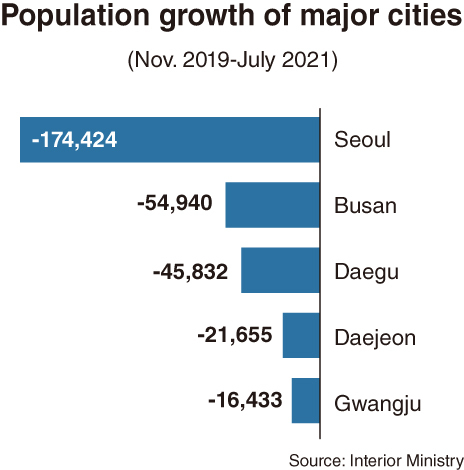[News Focus] Korea’s population decreases by 170,000 in 20 months
By Kim Yon-sePublished : Aug. 3, 2021 - 17:25

SEJONG -- South Korea’s population declined for the 20th consecutive month as deaths continuously outnumber births, government data shows.
According to the Ministry of Interior and Safety, the population fell 179,858 from 51.851 million in November 2019 (when the figure reached the record-high) to 51.671 million in July 2021. The downhill phase started in December 2019.
The nation’s population posted the lowest since it stood at 51.664 million in September 2016.
Seoul and Busan took the lead in the nationwide decline over the corresponding period, while the exceptional increase in two -- Gyeonggi Province and Sejong -- of the 17 major cities and provinces have somewhat slowed down the extent of the fall.
Seoul’s population decreased from 9.73 million in November 2019 to 9.55 million in July 2021.

The capital’s population is estimated to have peaked at 10.969 million in 1992, which means that Seoul has lost about 1.4 million residents (or 12.8 percent) in three decades. The city population fell below the 10 million mark in May 2016.
A growing number of Seoul citizens have moved to Gyeonggi Province in the wake of spiraling apartment prices. Gyeonggi Province is still absorbing residents from the capital, with its population reaching an all-time high of 13.51 million as of last month.
Busan, the second-largest city in Korea, lost 54,940 of its population over the 20-month period, falling to 3.36 million.
The demographic figure fell by 45,832 in Daegu (the fourth-largest city), 21,655 in Daejeon (fifth-largest) and 16,433 in Gwangju (sixth-largest).
Last month, deaths outnumbered births by 24,805 to 22,774 nationwide. While the gap between deaths and births was 2,031, other factors offset it somewhat, limiting the monthly population decrease to 831 people in July.
These included citizenship changes -- Koreans renouncing their citizenship and foreigners acquiring Korean citizenship -- and changes to the long-term residency status of Koreans overseas and foreign nationals here.
Relative to the population as a whole, the proportion of people under the age of 15 posted an all-time low of 12 percent last month. The youth population stood at 13.4 percent of the total five years earlier in July 2016 and 15.8 percent a decade earlier in July 2011.
On the contrary, the number of people aged 65 or over sharply climbed from 10.9 percent of the total in January 2011 to 13.2 percent in January 2016 and reached a record high of 15.6 percent in January 2021.
Further, 41.3 percent of the population, or 21.38 million people, were aged 50 or over as of last month. Octogenarians, nonagenarians and centenarians numbered 1.79 million, 256,245 and 10,818, respectively.
Among all age groups, those in their 50s took up the highest percentage of the total at 8.59 million. In contrast, there were only 3.84 million children under 10 and 4.73 million young people aged between 10 and 19.
In addition, those in their 60s (7.03 million) outnumbered those in their 20s (6.73 million) and those in their 30s (6.76 million).
The ministry data also showed that Korea, an aged society according to the standards set by the United Nations, saw the people’s average age reach a historic high of 43.5 (42.3 for men and 44.6 for women).
This contrasted with the average ages of 40.8 (39.6 for men and 42.0 for women) in July 2016 and 38.4 (37.3 for men and 39.6 for women) in July 2011.



![[Herald Interview] 'Amid aging population, Korea to invite more young professionals from overseas'](http://res.heraldm.com/phpwas/restmb_idxmake.php?idx=644&simg=/content/image/2024/04/24/20240424050844_0.jpg&u=20240424200058)












![[KH Explains] Korean shipbuilding stocks rally: Real growth or bubble?](http://res.heraldm.com/phpwas/restmb_idxmake.php?idx=652&simg=/content/image/2024/04/25/20240425050656_0.jpg&u=)

